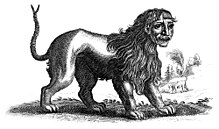Manticore
|
Manticore (1678)
|
|
| Grouping | Legendary creatures |
|---|---|
| Sub grouping | Mythological hybrids |
| Similar creatures | Sphinx |
| Mythology | Persian |
The manticore (Early Middle Persian Mardyakhor) is a Persian legendary creature similar to the Egyptian sphinx. It has the body of a lion, a human head with three rows of sharp teeth (like a shark), and sometimes bat-like wings. Other aspects of the creature vary from story to story. It may be horned, winged, or both. The tail is that of either a dragon or a scorpion, and it may shoot venomous spines to either paralyze or kill its victims. It devours its prey whole and leaves no clothes, bones, or possessions of the prey behind.
The Manticore myth was of Persian origin, where its name was "man-eater" (from early Middle Persian مارتیا mardya "man" (as in human) and خوار khowr- "to eat"). The English term "manticore" was borrowed from Latin mantichora, itself derived from the Greek rendering of the Persian name, μαρτιχώρα, martichora. It passed into European folklore first through a remark by Ctesias, a Greek physician at the Persian court of King Artaxerxes II in the fourth century BC, in his book Indica ("India"), which circulated among Greek writers on natural history but has survived only in fragments, or references by those other writers. The Romanised Greek Pausanias, in his Description of Greece, recalled strange animals he had seen at Rome and commented,
The beast described by Ctesias in his Indian history, which he says is called martichoras by the Indians and "man-eater" [androphagos] by the Greeks, I am inclined to think is the tiger. But that it has three rows of teeth along each jaw and spikes at the tip of its tail with which it defends itself at close quarters, while it hurls them like an archer's arrows at more distant enemies; all this is, I think, a false story that the Indians pass on from one to another owing to their excessive dread of the beast. (Description, 9.21.4)
...
Wikipedia

